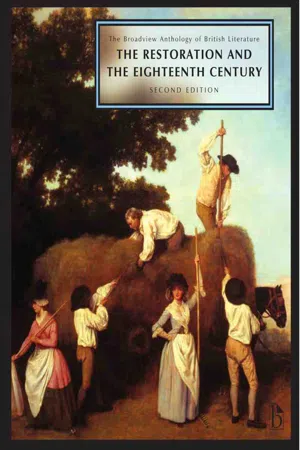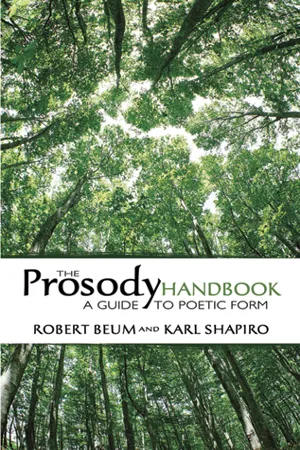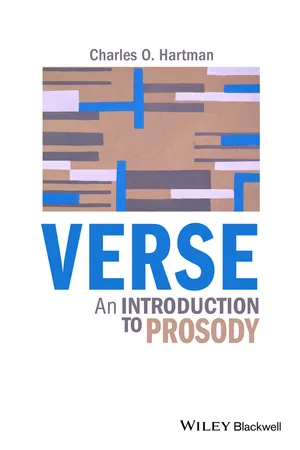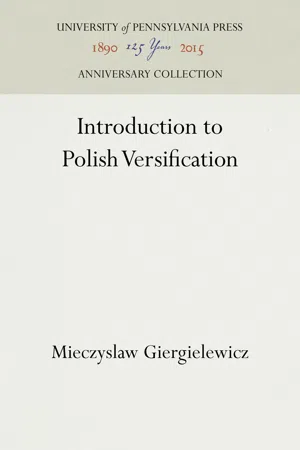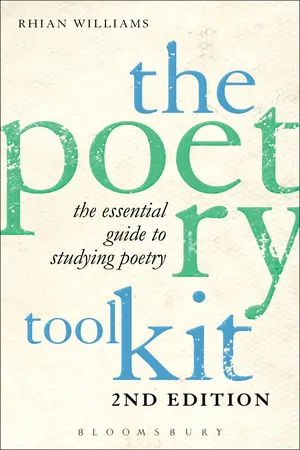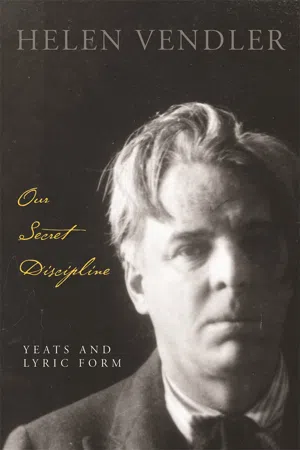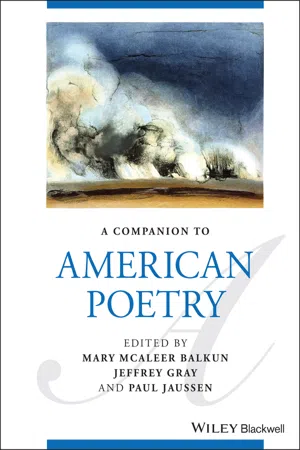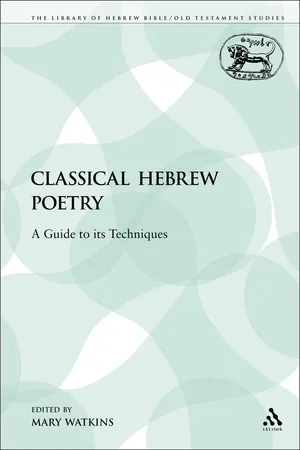Literature
Quatrain
A quatrain is a stanza in a poem that consists of four lines. It is a common form in poetry and can be found in various types of poems, including sonnets and ballads. Quatrains often follow specific rhyme schemes and are used to convey a complete thought or idea within the four lines.
Written by Perlego with AI-assistance
Related key terms
1 of 5
10 Key excerpts on "Quatrain"
- Joseph Black, Leonard Conolly, Kate Flint, Isobel Grundy, Wendy Lee, Don LePan, Roy Liuzza, Jerome McGann, Anne Lake Prescott, Barry Qualls, Jason Rudy, Claire Waters(Authors)
- 2012(Publication Date)
- Broadview Press(Publisher)
A ballad is typically divided into stanzas; a prose poem or a poem written in free verse, on the other hand, will rarely be divided into stanzas. A stanza may be identified by the number of lines and the patterns of rhyme repeated in each grouping. One of the simpler traditional forms is the ballad stanza , with its alternating four and three-foot lines and its abcb rhyme scheme. Drawing on this form’s association with medieval ballads and legends, Keats produces the eerie mystery of “La Belle Dame Sans Merci”: I saw pale kings and princes too, Pale warriors, death-pale were they all; They cried—“La Belle Dame sans Merci Hath thee in thrall!” Such imitations are a form of literary allusion; Keats uses a traditional stanza form to remind us of poems like “Sir Patrick Spens” or “Barbara Allen” to dramatize the painful thralldom of love by placing it within a well-known tradition of ballad narratives with similar forms and themes. The four-line stanza, or Quatrain , may be used for a variety of effects: from the elegiac solemnity of Gray’s “Elegy Written in a Country Churchyard” to the apparent lightness and simplicity of some of Emily Dickinson’s poems. Tennyson used a rhyming Quatrain to such good effect in In Memoriam that the form he employed (four lines of iambic tetrameter rhyming abba ) is known as the “In Memoriam stanza.” Other commonly used forms of stanza include the rhyming couplet , terza rima , ottava rima , rhyme royal , and the Spenserian stanza . Each of these is a rhetorical unit within a longer whole, rather like a paragraph within an essay. The poet’s choice among such forms is dictated, at least in part, by the effects that each may produce.- eBook - PDF
- Joseph Black, Leonard Conolly, Kate Flint, Isobel Grundy, Wendy Lee, Don LePan, Roy Liuzza, Jerome J. McGann, Anne Lake Prescott, Barry V. Qualls, Jason Rudy, Claire Waters(Authors)
- 2017(Publication Date)
- Broadview Press(Publisher)
If such a group of lines is not patterned as one of a recurring group sharing similar formal characteristics, however, then it may be more appropriate to refer to such irregular groupings in the way we do for prose—as paragraphs. A ballad is typically divided into stanzas; a prose poem or a poem written in free verse, on the other hand, will rarely be divided into stanzas. A stanza may be identified by the number of lines and the patterns of rhyme repeated in each grouping. One of the simpler traditional forms is the ballad stanza , with its alternating four and three-foot lines and its abcb rhyme scheme. Drawing on this form’s association with medieval ballads and legends, Keats produces the eerie mystery of “La Belle Dame sans Merci”: I saw pale kings and princes too, Pale warriors, death-pale were they all; They cried—“La Belle Dame sans Merci Hath thee in thrall!” Such imitations are a form of literary allusion; Keats uses a traditional stanza form to remind us of poems like “Sir Patrick Spens” or “Barbara Allen” to dramatize the painful thralldom of love by placing it within a well-known tradition of ballad narratives with similar forms and themes. 1236 Reading Poetry The four-line stanza, or Quatrain , may be used for a variety of effects: from the elegiac solemnity of Gray’s “Elegy Written in a Country Churchyard” to the apparent lightness and simplicity of some of Emily Dickinson’s poems. Tennyson used a rhyming Quatrain to such good effect in In Memoriam that the form he employed (four lines of iambic tetrameter rhyming abba ) is known as the “In Memoriam stanza.” Other commonly used forms of stanza include the rhyming couplet , terza rima , ottava rima , rhyme royal , and the Spenserian stanza . Each of these is a rhetorical unit within a longer whole, rather like a paragraph within an essay. The poet’s choice among such forms is dictated, at least in part, by the effects that each may produce. - eBook - ePub
The Prosody Handbook
A Guide to Poetic Form
- Robert Beum, Karl Shapiro, Karl Shapiro(Authors)
- 2012(Publication Date)
- Dover Publications(Publisher)
Triplets are relatively rare in English, and there are no first-rate triplet poems of any considerable length. It is difficult to find sufficient rhyme, and difficult to endure such intense rhyming for more than a few stanzas. The Augustan poets sometimes allowed triplets in their heroic couplet poems, especially when an effect of expansion or intensification was desired. Robert Bridges’ octosyllabic couplet poem “Eros” ends with a triplet that is strikingly effective by contrast.EXAMPLESterza rima SHELLEY, Ode to the West Wind; BROWNING, The Statue and the Bust triplets GEORGE HERBERT, Paradise; ROBERT HERRICK, Upon Julia’s Clothes III. QuatrainS
The favorite English verse form is the Quatrain, a stanza of four lines. Eight types of Quatrains are fairly common: (1) the ballad stanza, (2) the long ballad, (3) the short ballad, (4) the heroic Quatrain, (5) the Rubaiyat stanza, (6) the In Memoriam stanza, (7) the brace stanza, and (8) the unrhymed Quatrain (often called a tetrastich). Ordinarily all of these are iambic, but trochaic Quatrains are not rare, and traditionally the three ballad stanzas freely admit anapests and other types of feet.There is nothing mysterious about the popularity of Quatrains. Where the rhyme is alternating, they can be constructed as a two-part structure, making balance, parallelism, and antithesis quite feasible. And they save rhyme in a rhyme-poor language. When a relatively short and self-contained stanza is required, the Quatrain is ready to hand. The interweaving, forward-pulling effects of terza rima rule out that form, and the tercet and the five-line stanza provide little opportunity for balance and antithesis. The five-line stanza (e.g., ababa; abbab; ababb) raises the problem of finding three identical rhymes, and so of course does the triplet, which has the additional disadvantage that it tends to cloy. Following are some Quatrain patterns.1. Ballad Stanza
Lines I and 3 are iambic tetrameter, 2 and 4 trimeter; rhyme schemes abab or xaxa.A slumber did my spirit seal; a I had no human fears; b She seemed a thing that could not feel a The touch of earthly years. b There lived a wife at Usher’s well, x And a wealthy wife was she; a She had three stout and stalwart sons, x And sent them o’er the sea. a 2. Long Ballad
- eBook - ePub
Verse
An Introduction to Prosody
- Charles O. Hartman(Author)
- 2015(Publication Date)
- Wiley-Blackwell(Publisher)
(Internal rhyme foregrounds the opposition between “reveal” and “conceal.”) The abba pattern, by joining the beginning to the end, emphasizes each stanza’s closure. This one starts with a notion of “sin” and is rounded out by “the Soul within.” In between is a tightly rhymed couplet (“feel / reveal”). At the same time, the syntax of the sentence is divided sharply after the second line. The rhyming structure is one of enfolding – the outer rhymes embrace the inner ones – while the structure of the sentence makes the last two lines feel like a reversal of the first two. Two different ideas about structure jostle against each other. Poets often use this kind of double patterning – in stanzas as in other aspects of the poem’s language – to heighten our sense that the poem is working to organize complex thought and feeling.Quatrains can even be made from pairs of couplets (aabb). Here is Percy Shelley’s poem (1824) called “To – ”:/ | x x / / | x / Music, when soft voices die, / | x (/) | x / | x (/) Vibrates in the memory – / | x x / / | x / x Odours, when sweet violets sicken, / | x / | x / | x / x Live within the sense they quicken/ | / x | x / | x / Rose leaves, when the rose is dead, x / | x (/) | x / | x / Are heaped for the beloved’s bed; x / | x / | x / | x / And so thy thoughts, when thou art gone, / | x / | x / | x (/) Love itself shall slumber on.This is the least usual rhyme scheme for the Quatrain. It has the oddly resonant effect of doubling each stage in the development of the rhyming structure. It might seem not to matter whether this poem is printed as Quatrains or as couplets, but the four-line stanza contributes to the sense of doubling: the poem is in two parts, each made of halves, each of which is a pair of rhymed lines.One of the most common Quatrain forms, the ballad stanza, is originally a song form, and we’ll see it again in Chapter 5 - eBook - PDF
- Mieczyslaw Giergielewicz(Author)
- 2015(Publication Date)
Baroque poetry, especially in its earlier period, added a considerable number of new forms. In the eighteenth century this fertility waned, as the Classicists were more concerned about other facets of poetics. The Romanticists revived interest in the stanza. Oxytonic rhyming and the development of the syllabic-accentual system provided other elements for stanza making. At the end of the last century elaborate and sophisticated types were valued. Translators of poetry transferred some varieties from other languages. Among numerous stanza forms introduced in Polish poetry only a limited number gained widespread popularity and had any significant influence on its development. To this select group belong many modifications of the Quatrain, the sextet, the octave, and the sonnet, with the addition of the couplet, the tercet and the cinquain. Other forms, although less popular, were not deprived of significance. The adapt-ability of Polish to the rigid requirements of the most elaborate stanzas was unquestionable. In the definition of the stanza, the following elements are to be considered: a. Number of lines b. Their metric structure c. Rhyming arrangement d. Repetitive components (refrain) e. Syntactic pattern f. Intonation 2. The Quatrain Four-line stanzas were the most popular. The first Quatrains appeared in Poland with the earliest specimens of syllabic 1 4 8 Introduction to Polish Versification verse. The song Piesn o m§ce Panskiej (quoted in Chapter II) consisted of the 4-line 13-syllable stanzas with the femi-nine rhymes arranged in the pattern aabb. This form was quite widespread in European poetry of the Middle Ages. At that time lines followed the syntactic structure of the text. Fifteenth-century Quatrains could consist of shorter lines, including the 8-syllable verse. As the texts were written for singing, the stanzas corresponding to the tune of the song had to be shaped as separate units. - eBook - PDF
- Rhian Williams(Author)
- 2013(Publication Date)
- Bloomsbury Academic(Publisher)
It is particularly prevalent in the ballad tradition, and in the fixed French forms such as the villanelle and the ballade , but they also feature in lyric poems Stanza A group of poetic lines, defined by its arrangement of metre and rhyme . Feet, lines and rhymes of poetry have been considered; now we come to how all of these features come together into particular poetic arrangements. ‘Stanza’ is the name given to blocks of formal poetry; commonly these blocks are called ‘verses’ (especially with reference to songs), but stanza is clearer. (Note however that in blank verse such divisions are known as verse paragraphs .) ‘Stanza’ is often etymologically linked via Latin to the Italian for ‘stopping place’, but the term also applies in Italy to a chamber or room and this latter root is more helpful in thinking about the definition of a stanza of poetry. We may think that a room is most obviously defined by its function and content (beds in bedrooms; ovens in kitchens). Framing this functional definition, however, is a room’s dimensions (the length of its walls) and its decor. A stanza’s line lengths may be likened to its ‘walls’ (which form a particular set of dimensions on the page) and the rhyme scheme , which decorates the line lengths, becomes the wallpaper. In this section stanzas are arranged primarily in terms of their dimensions – the number of lines included in each – since all stanzas may be described most simply in this way. In certain fixed or named stanza arrangements the rhyme scheme or metre is specified, so these are also given in each definition. 5.1 One-line stanzas and refrains Stanza 183 as a case of heightened or concentrated emotion. A famous example is Alfred Tennyson’s ‘Lady of Shalott’ (1832), in which the subject’s name is repeated as a refrain in the final line of every stanza . - eBook - PDF
Our Secret Discipline
Yeats and Lyric Form
- Helen Vendler(Author)
- 2007(Publication Date)
- Belknap Press(Publisher)
VII i The Nationalist Measure: Trimeter-Quatrain Poems In Yeats’s poems, trimeter lines appear by themselves in many stanza forms—as the second and fourth lines of the ballad stanza, for example. In this chapter I examine only entire poems (or segments of sequences) writ-ten in trimeter, 1 and, within this class, only the subset of seventeen poems that exhibit “perfect” Quatrain rhyme, abab. 2 First attempted in 1913 with “To a Friend Whose Work Has Come to Nothing,” abab trimeter-Quatrain form acquired for Yeats, I believe, an independent nationalist meaning, first with respect to “aristocratic” women, and then also with respect to “heroic” or “noble” men. The most famous of such poems is “Easter 1916”; other well-known ones are “The Fisherman” and part III of “The Tower,” Yeats’s poetic last will and testament. (The appendix to this chapter gives a com-plete list of the seventeen trimeter-Quatrain poems, with their respective sub-forms—number of stanzas, types of rhymes, and so forth.) Why did Yeats shape one group of his poems in trimeter Quatrains rhyming abab? In casting “raw material” into metrical form, he certainly did not (as this book exists to show) decide on forms at random. In the preced-ing chapters I have tried to explain what some traditional forms meant to him, and how he renewed them. Now I turn to the trimeter Quatrain, to see what it is possible to say about how Yeats used this form, and what sort of material invited or required it. Iambic trimeter poems in alternately rhymed abab Quatrains (hence-forth, for brevity, “ abab trimeters” or “trimeter Quatrains”) have no distin-guished history in English verse before Yeats. Hundreds of ballads, hymns, and lyrics exist in the form of alternating tetrameter and trimeter (“God rest ye merry gentlemen / Let nothing you dismay”), but rhyming iambic trimeter is rare. 3 When, as a girl, I first read a poem in sustained trimeter, I found it thrilling; I had never before encountered this striking rhythm. - eBook - PDF
- John Singleton, Mary Luckhurst, John Singleton, Mary Luckhurst(Authors)
- 2000(Publication Date)
- Bloomsbury Academic(Publisher)
The lines, and the groups, may be regular in one or another way, as in limericks and sonnets; or they may be irregular, creating a new form 164 WRITING VERSE 165 unique to that poem: but in all cases there is a form, so again the choice is not whether to have a form, but whether you attend to the form. Poetry has varied enormously over time (as you can see by paging through the Norton Anthology), and because people have often been taught poetry narrowly at school there are common misconceptions about 'what poetry is'. Before the twentieth century most poetry in English was written in regu-lar metres (or patterns of stress), so that each line has a similar rhythm; and in prescribed forms, so all the lines are either of the same length, or vary in a regular way. Poems of this kind often have a regular pattern of end-rhymes (called the rhyme scheme): but this does not mean that 'all poems rhyme', nor that 'if it rhymes it's a poem'; and in the twentieth century (especially since T. S. Eliot's The Waste Land [1922]: N1236) free verse (where the metrical pattern varies from line to line) and open form (where the line lengths and rhyme scheme are ir-regular) have become increasingly popular. There is still metre, and form: but they are freed from preset rules and limits. You may want to write more traditional poetry (and many poets, like Tony Harrison, have continued to use regular metres and forms), or you may want to experiment with free verse, but in either case you will need to understand metre and form, to make them regular or to control their irregularities. Metre and form are very general terms, and each can be subdivided in many ways (some of which are explored in the Workshop Writing and Writing On sections). - eBook - PDF
- Mary McAleer Balkun, Jeffrey Gray, Paul Jaussen, Mary McAleer Balkun, Jeffrey H. Gray, Paul Jaussen, Mary McAleer Balkun, Jeffrey H. Gray, Paul Jaussen(Authors)
- 2022(Publication Date)
- Wiley-Blackwell(Publisher)
Their twinned sound and silence rings out as a negation of the Quatrain and the beliefs it contains. The Quatrain is not a major presence in Brown, Kearney, Sanchez, and others discussed here (Harryette Mullen’s Muse & Drudge would be an important exception 6 ). Nor is the “Ballad” a prominent subcurrent in an anthology like Understanding the New Black Poetry or in Gwendolyn Brooks’ oeuvre after her “Last Quatrain.” The more recognizable forms of Quatrain and ballad are marginal in post-war black poetry, at least compared with their frequency in the lyric model of Dunbar, the “nightingale” tradition of Georgia Douglas Johnson, the vernacular “blues ballads” of Sterling Brown, and Brooks’ work through Blacks . Yet this essay hopes to have made the case for treating such “pseudomorphic” forms as ideal grounds for understanding black poetics. Unlike free verse, the Quatrain helps poets feel out, bracket, and ironize racial form as that which is consistently hypostatized, preemptively embodied, and ultimately locked into neoliberal strivings for simplified, apolitical multicultural identity. It does this critical work as jazz does, destabilizing medium, voice, and expressive logic, but the black Quatrain works firmly within the contested space of poetry’s traditional forms and genres. It tells us to recognize our too-easy recognitions, to listen again to what is over-heard, to stop treating non-white poets as embodied media, and to feel the violence and misprisions of our literary and racial formalisms. 7 Notes 1. For Gates’ response to the “Black Aesthetic,” and his theory of blackness as “metaphor or sign” rather than “entity,” see Figures in Black , 1989, p. 39 and follow-ing. On the stereotype of the “naturally musical black,” see Sanders 1999, p.73. bell hooks observes critiques of essentialism across Black feminist schol-arship and in her own concept of “post-modern blackness” (Hooks 1991, p. 172). - eBook - PDF
Classical Hebrew Poetry
A Guide to its Techniques
- Wilfred G. E. Watson(Author)
- 1984(Publication Date)
- Sheffield Academic Press(Publisher)
Smith, Closure. 2. Kraft: 1938. See note 4. Stanza and Strophe 161 updated with a discussion of the stanza in Ugaritic. 3 There have been other, sporadic studies (see bibliography), the most significant being de Moor's pioneering paper 4 to which fuller reference will be made later. Definitions The stanza is a subunit within a poem, and a strophe is a subunit within a stanza. This is the basic principle underlying the definitions to be set out, the axiom from which further explanations derive. A poem can be considered as the starting-point (or unit); within that unit are one, two, three or more stanzas which comprise the poem as a whole. And each stanza, in its turn, is made up of strophes (and, of course, the strophes consist of varying numbers of verse-lines). A diagram will make this clear: The stanza can be broadly defined as a subdivision of a poem—or better, a major subdivision of a poem—which comprises one or more strophes. Intentionally, the aspect of regularity is omitted from the definition; it is not excluded nor yet is it prescribed. From the range of definitions surveyed by Haublein, 5 his own is perhaps the best: 'The Italian etymology (a room of a house) implies that stanzas are 3. C.F. Kraft, 'Some Further Observations Concerning the Strophic Structure in Hebrew Poetry', Hobbs FS, 62-89. 4. De Moor, UF 10 (1978) 187-217; note his remarks on regularity, 196-197. Van der Lugt, Strofische Structuren, only became available after the present work was in its final stages. 5. Haublein, Stanza, 1-17. POEM STANZA I STANZA II STANZA III strophe 1 strophe 2 strophe 3 strophe 1 strophe 2 strophe 1 strophe 2 strophe 3 strophe 4 162 Classical Hebrew Poetry subordinate units within the more comprehensive unity of the whole poem'. 6 If this analogy is insisted on, then stanza = room and poem = house; it follows that stanzas can all have the same form (correspond-ing to a house constructed of totally uniform rooms), or can have varying shapes and sizes.
Index pages curate the most relevant extracts from our library of academic textbooks. They’ve been created using an in-house natural language model (NLM), each adding context and meaning to key research topics.
